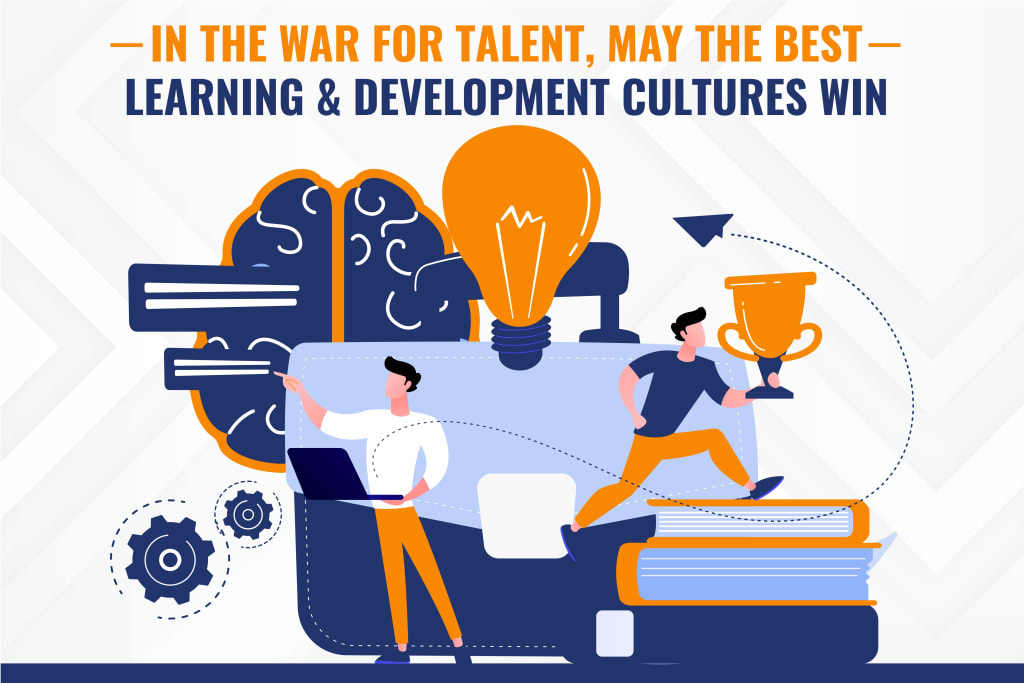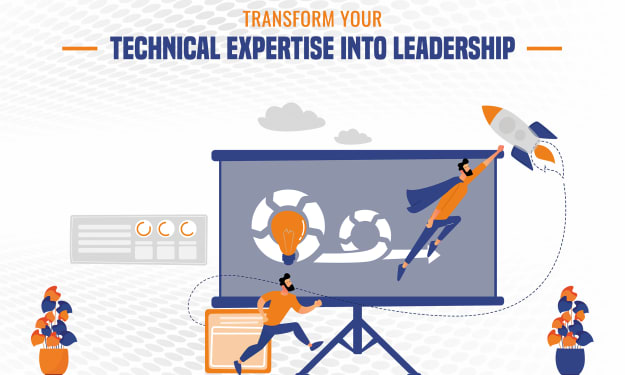In The War For Talent, May The Best Learning & Development Cultures Win
In the present-day scenario where there’s fierce competition for talent, organizations with the most effective and progressive Learning & Development cultures emerge as the winners, attracting and retaining top talent.

Introduction
In today's fiercely competitive business landscape, talent acquisition, and retention have become crucial for organizations striving for success. To gain an edge, companies are engaging in a war for talent, where the winners are those who can attract and retain the best employees. In this battle, learning and development (L&D) cultures play a pivotal role. Companies that prioritize creating a robust L&D culture have a greater chance of attracting top talent and nurturing their growth. In this article, we will explore the significance of learning and development cultures and how they can become the differentiating factor in the war for talent.
What Is a Learning & Development Culture?
A learning and development culture refers to an organization's collective mindset, values, and practices regarding employee growth and skill enhancement. It encompasses the organization's commitment to providing opportunities for learning, both formal and informal, and the emphasis on continuous development or to be more precise, comprehensive Leadership training and development. A strong L&D culture encourages employees to pursue professional growth, enabling them to acquire new skills, enhance existing ones, and stay updated with industry trends and best practices.
Why Are Learning & Development Cultures Crucial in the War for Talent?
In the war for talent, companies with strong learning and development cultures have a significant advantage. Here's why:
Attracting Top Talent:
Attracting top talent is a key advantage for organizations that prioritize employee development. Exceptional candidates actively seek out companies that value continuous learning and growth opportunities. By showcasing a robust learning and development culture, such as Leadership Development Training for employees, companies can create a magnetic appeal for high-potential individuals who are enthusiastic about expanding their knowledge and skills. These candidates are eager to join organizations that invest in their professional development, providing them with the platform to excel and achieve their career aspirations.
Retention of Employees:
Retaining employees is greatly influenced by an organization's investment in their development. When a company fosters a strong learning and development culture, it cultivates a sense of loyalty and commitment among employees. By providing opportunities for growth and skill enhancement, organizations demonstrate their dedication to the personal and professional advancement of their workforce.
As a result, employees feel valued and supported, leading to higher job satisfaction and a decreased likelihood of seeking employment elsewhere. A robust learning and development culture becomes a powerful tool for reducing turnover rates and building a stable and dedicated team.
Enhanced Productivity:
Continuous learning opportunities have a direct impact on employee productivity. When organizations provide employees with access to ongoing learning initiatives, it equips them with the tools to become more efficient and effective in their roles. By acquiring new skills and knowledge, employees can apply innovative approaches to their work, driving growth and progress within the organization.
The application of these newly acquired skills enhances problem-solving abilities, encourages creativity, and fosters a culture of continuous improvement. As a result, productivity levels soar, and employees are better equipped to meet the challenges of a dynamic and evolving business landscape. All in all, it promotes better Leadership Development.
Adaptability to Change:
In the ever-evolving business landscape, organizations must possess the ability to adapt quickly and effectively. A strong learning and development culture plays a vital role in fostering adaptability within employees. By cultivating a growth mindset, organizations encourage their workforce to embrace change and view it as an opportunity for growth and development.
Employees with a growth mindset are more open to acquiring new skills, expanding their knowledge base, and exploring innovative approaches to tackle evolving market dynamics. This adaptability empowers employees to navigate through uncertain times, respond promptly to industry shifts, and contribute to the organization's overall resilience and success in a rapidly changing business environment.
Positive Employer Branding:
Prioritizing employee development not only enhances internal dynamics but also positively impacts external perceptions of an organization. Companies that place a strong emphasis on learning and development cultivate a positive employer brand. These organizations become attractive workplaces for talented individuals seeking opportunities for growth and advancement in the form of Corporate leadership development program. A reputation for investing in employees' professional development resonates not only with potential employees but also with customers and clients who value a commitment to continuous improvement. A positive employer brand not only aids in attracting top talent but also strengthens relationships with clients, as they associate the organization with a culture of excellence, innovation, and dedication to the continuous enhancement of skills and capabilities.
How to Cultivate a Strong Learning & Development Culture
Creating a robust learning and development culture requires a strategic approach. Here are key steps to cultivate such a culture within an organization:
Leadership Commitment
Establishing a strong learning and development culture requires unwavering commitment from organizational leaders. When leaders prioritize the growth and development of their employees, it creates a ripple effect throughout the entire organization. Executives play a crucial role by actively participating in learning initiatives, leading by example, and encouraging employees to seize development opportunities.
By allocating resources for Corporate Leadership Training programs, skill-building workshops, and educational resources, leaders demonstrate their dedication to nurturing talent and fostering a culture of continuous learning. Leadership commitment sets the tone, signaling to employees that their growth and development are valued and supported, ultimately driving the success of the learning and development culture within the organization.
Align L&D with Business Goals
For learning and development initiatives to have a significant impact, it is crucial to align them with the strategic goals of the organization. By identifying the key skills and competencies required to achieve business objectives, companies can design targeted L&D programs. These programs address specific skill gaps and provide employees with the necessary knowledge and capabilities to contribute effectively to the organization's growth.
Aligning L&D with business goals ensures that learning initiatives are purposeful, relevant, and directly tied to the success of the organization. It allows companies to optimize their resources and focus on developing the skills that are most critical for driving overall performance and achieving long-term success.
Encourage Continuous Learning
Promote a culture of continuous learning by encouraging employees to seek new knowledge and skills regularly. Offer a variety of learning opportunities, such as workshops, webinars, conferences, online courses, and mentorship programs. Emphasize the importance of personal growth and provide resources that enable employees to pursue their professional development goals.
Recognize and Reward Learning
To foster a strong learning and development culture, it is essential to recognize and reward employees who exhibit a dedication to growth. Acknowledging their accomplishments, such as earning certifications, completing Leadership Development Training programs, or actively sharing knowledge with colleagues, sends a powerful message about the organization's commitment to continuous development.
By celebrating these achievements, organizations reinforce the value of learning and highlight its significance in personal and professional growth. Recognizing and rewarding employees who embrace learning cultivates a positive environment that encourages others to actively pursue their own development, leading to a more engaged and motivated workforce.
Provide Accessible Learning Resources
Creating a learning-friendly environment involves providing accessible resources to employees. Establishing a centralized learning platform allows for easy access to training materials, online courses, and other relevant resources. By investing in user-friendly technologies, organizations enable employees to engage in self-paced learning, acquiring knowledge and skills at their own convenience.
These accessible learning resources empower individuals to take ownership of their development journey, fostering a culture of continuous learning. Whether it's through virtual libraries, e-learning modules, or interactive training platforms, organizations can ensure that employees have the tools they need to expand their knowledge and grow professionally.
Promote Collaboration and Knowledge Sharing
Promoting collaboration and knowledge sharing among employees is vital for a thriving learning and development culture. Organizations can encourage collaboration by facilitating cross-functional teams, establishing communities of practice, or implementing mentorship programs for Leadership Development. These initiatives create opportunities for individuals to learn from one another, leveraging diverse perspectives and experiences.
By fostering a supportive environment that values collaboration, organizations promote the exchange of ideas and expertise. Employees can share their knowledge, insights, and best practices, collectively enhancing the learning experience for everyone involved. Collaboration not only accelerates learning but also fosters a sense of camaraderie and teamwork, leading to increased engagement and a more innovative and adaptive workforce.
Frequently Asked Questions (FAQs)
1. Q: How can a learning and development culture help attract diverse talent?
A: A learning and development culture can attract diverse talent by demonstrating an organization's commitment to inclusion and equal opportunity. When companies prioritize employee development and create an environment that supports learning for all, they send a strong message that diverse perspectives are valued and encouraged.
2. Q: What role does technology play in building a strong learning and development culture?
A: Technology plays a crucial role in building a strong learning and development culture by providing accessible and scalable learning solutions. Online learning platforms, virtual classrooms, and e-learning modules enable employees to access training materials anytime, anywhere. Technology also facilitates data-driven learning analytics, helping organizations track the effectiveness of their L&D initiatives.
3. Q: How can small businesses with limited resources foster a learning and development culture?
A: Small businesses can foster a learning and development culture by leveraging cost-effective solutions. They can tap into free online resources, utilize open-source learning platforms, and encourage peer-to-peer knowledge sharing. Additionally, partnering with local educational institutions or industry associations can provide access to affordable training programs and networking opportunities.
4. Q: What are some signs of a strong learning and development culture within an organization?
A: Signs of a strong learning and development culture include high employee engagement in learning activities, a wide range of available learning resources, a supportive and collaborative work environment, opportunities for continuous feedback and growth, and clear career progression paths based on skill development.
5. Q: How can companies measure the effectiveness of their learning and development programs?
A: Companies can measure the effectiveness of their learning and development programs through various metrics, such as employee feedback and satisfaction surveys, knowledge assessments, performance evaluations, and tracking the application of newly acquired skills in day-to-day work. It's essential to establish clear learning objectives and regularly evaluate the impact of L&D initiatives on employee performance and organizational outcomes.
6. Q: Can a learning and development culture help organizations stay ahead in a rapidly evolving market?
A: Yes, a learning and development culture can help organizations stay ahead in a rapidly evolving market. By fostering a mindset of continuous learning, companies can equip their employees with the skills and knowledge necessary to adapt to changing market trends, embrace new technologies, and seize emerging opportunities.
Final Words
In the war for talent, organizations that cultivate strong learning and development cultures emerge as winners. By prioritizing employee growth, offering continuous learning opportunities in the form of Leadership Development Training, and creating a supportive environment, companies attract top talent, retain valuable employees, enhance productivity, and build a positive employer brand. As businesses navigate the ever-changing landscape, a robust learning and development culture becomes a crucial differentiating factor. So, in the war for talent, may the organizations with the best learning and development cultures reign supreme.
About the Creator
Christina
Writer
If you can dream it, You can Do It
Enjoyed the story? Support the Creator.
Subscribe for free to receive all their stories in your feed. You could also pledge your support or give them a one-off tip, letting them know you appreciate their work.






Comments
There are no comments for this story
Be the first to respond and start the conversation.